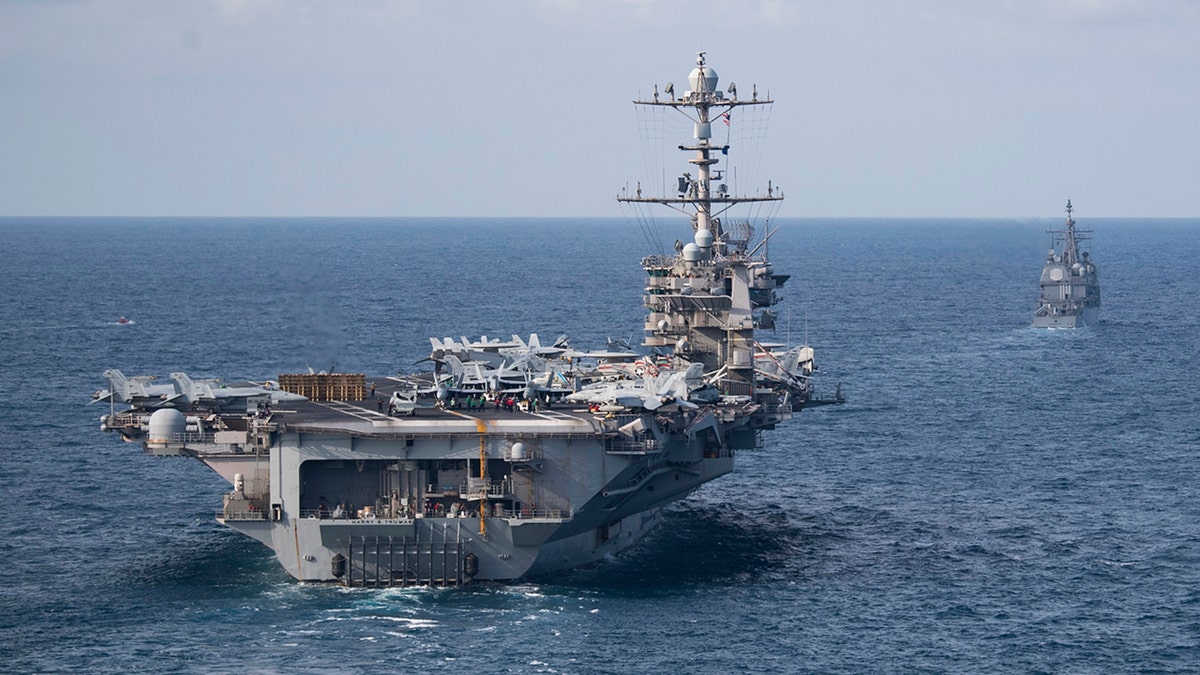
The Nimitz-class aircraft carrier USS Harry S. Truman, front - file photo. (U.S. Navy photo by Mass Communication Specialist 2nd Class Scott Swofford)
They are floating attack machines, small cities on the seas and visible examples of U.S. military power -- and the Pentagon now plans to operate 11 of them.
Aircraft carriers -- long seen as an indelible image of U.S. strength -- have multi-faceted missions such as maintaining safe passageway through the world’s key waterways, deterring potential enemies by ensuring massive retaliatory strike possibility and, of course, waging war on enemies from the seas.
The Trump administration, Pentagon and Navy have now carved a decided path toward a total number of 11 carriers, effectively ending the longstanding debate about how many the U.S. should maintain. Some decision-makers, particularly in the last administration, argued that the Navy could function effectively with only 10 carriers, citing cost and modernization factors. The thinking, as articulated by advocates at the time, was to save money by operating fewer carriers, yet make specific strides to ensure they remain technologically superior. However, Navy leaders and many Pentagon decision-makers have long-cited the fact that the global combatant commander need for carriers has consistently exceeded the number of available carriers. Now, Navy developers say legislation approved for next year has inspired current efforts to “move out” on procurement and preparation for the 11th carrier.
NAVY MAY ARM NEW DESTROYER WITH CONVENTIONAL MISSILE ABLE TO HIT ANYWHERE ON EARTH IN AN HOUR
Most of the questions centered upon whether the USS Truman, a Nimitz-class carrier, would complete its mid-life refueling process for further service… or retire early.
"NDAA (2020 Defense Bill) language re-emphasized the need for 11 aircraft carriers and there was money appropriated by Congress in the FY20 budget to begin advanced planning for the Truman's refueling. I received that money and have initiated planning efforts and the procurement of long-lead materials," Capt. Charles Ehnes, in-service aircraft carrier program manager, told an audience at the Surface Navy Association Annual Symposium in Arlington, Va. on Jan. 16.
A key reason for more carriers, it would seem appropriate, is readiness. Should conflict quickly emerge in various global hotspots, or in unanticipated areas, forward-positioned Carrier Air Wing attack makes power projection much faster and more effective. It brings an advantage of strike proximity in the event that land-launch bases are not immediately within striking range. Also, as mobile attack platforms, carriers can maneuver into positions of strategic advantage, should new intelligence information change the equation. Furthermore, by bringing massive attack possibilities to areas of tactical relevance, carriers can provide a kind of "back up" attack protection to forward operating assets such as drones and surveillance planes. Should an adversary be aware of U.S. carriers in striking range, they might be less inclined to risk confrontation by attacking U.S. assets, such as U.S. bases or surveillance planes. In effect, carriers are deterrents.
NAVY STRATEGY FAST-TRACKS NEW WEAPONS FOR 'OFFENSIVE' ATTACK
Apart from the expected need for warfare preparedness, carriers are essential to maintaining secure and open global waterways. Much of the Navy's mission, as articulated by senior leaders over the years, involves forward-positioning combat power to ensure safe passage for free trade, friendly travel and international business. U.S. carriers can, in this respect, also perform counterterrorism missions and prevent piracy. Given all these variables, many senior Navy leaders have, for quite some time now, been of the view that current global mission demands simply exceed the amount of available carrier capacity.
All of this aligns with the Navy’s current push to make carriers more combat-capable. This strategy appears to have a few possible dimensions. While carriers typically operate in Carrier Strike Groups surrounded by cruisers, destroyers and other warships able to provide protection, a fast-changing threat environment is expected to create the need for more dispersed, or disaggregated operations -- requiring carriers themselves to operate with more integrated offensive and defensive weapons systems.
CLICK HERE TO GET THE FOX NEWS APP
The F-35C, naturally, will bring a new array of attack options for the Carrier Air Wing, not to mention an unprecedented measure of aerial Intelligence, Reconnaissance and Surveillance (ISR). Drawing upon new sensor and targeting technology, the aerial attack range will be significantly changed, and stealth technology will enable air attack to operate in higher threat environments, such as areas containing advanced air-defenses.




















